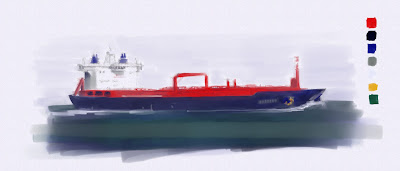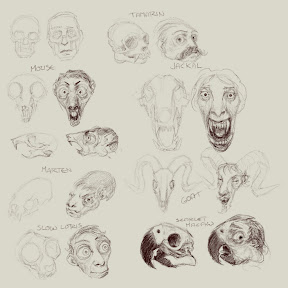
Recently I've been using
MyPaint to draw and paint. MyPaint is an open source painting program with a really nice brush engine and lots of good preset brushes (even if I mostly end up using just five...) Anyhow, this is my attempt at describing how I paint a picture with it.
I'm using this
Cormorant photo from Wikipedia as a reference. I had the photo open on the other monitor while painting. As I'm working from a photo, this tutorial is less about constructing and lighting a cormorant and more about expressing the shapes and colors of something you see.
I'm not a total master expert of painting, so if I'm saying something wrongheaded and stupid, it's your responsibility to set me right! Now, let's get started.
At 0 minutes, start the timer!
The first step is picking a background canvas: I went to Layers -> Background... and picked a nice blue one (so that I don't have to work so much filling in the background color). Then I picked the 6B pencil from the brush window and drew a rectangle to act as my work area. It gives you some structure to work with.

I tend to have the brush selection window and the color sampler open when I'm working (B and T are the hotkeys to toggle those, respectively). MyPaint is very much hotkey-driven. Keep your other hand on the keyboard and draw with the other. The main hotkeys are 'd' and 'f' to control brush size, 'r' picks the color under the cursor, 'i' mirrors the canvas, and '.' and ',' zoom.
At 6 minutes
Next, I drew a rough sketch of the cormorant, focusing on proportions, basic structure and value separators. Drawing a polygonal sketch using straight lines helps with getting the angles and proportions right.
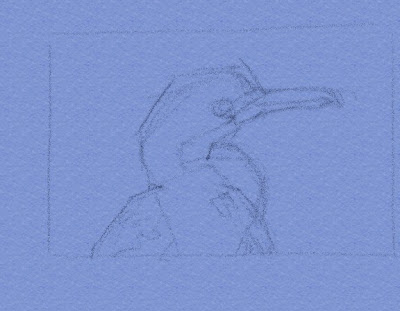
At 9 minutes
I mirrored the sketch to see it in a new light (helps spot problems). The beak was a bit too thick, so I toned it down. Then I picked the flat wet brush from the brush window and set down five colors for the palette.

The palette I use depends on the image, but it usually has a dark value, a light value, a medium value, some basic colors plus grey. Here the dark color is nearly black red, the white is yellowish, the blue is for shadows (water & sky reflection), the orange is for feathers, the grey is for shadows and doing saturation contrasts.
Putting down a palette before painting helps me a lot. Without a palette, I have a tendency to get stuck in smudgy midtones with no color variation. And a small palette somehow helps with getting impact in some strange manner. Maybe it makes the results more graphic? Dunno.
At 10 minutes

I started painting by putting down the shadow parts. When I ended up covering the drawing, I redrew the lines with the brush.
At 12 minutes

Next I picked the blue and did the white shadows with it and jotted down some background.
At 14 minutes

I used white to do the lit areas. At this point, the image is pretty much done and the rest is just refinement :)
At 18 minutes
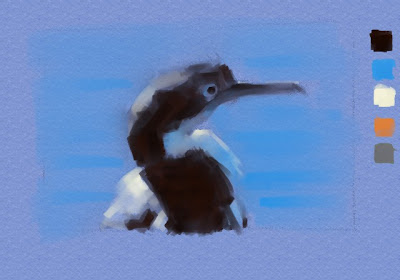
Brought down the darks and refined the edges. The light-dark edges are pretty much _the_ defining feature in an image. If you get them right, you can just about screw up the rest of the picture and it still comes out alright.
The wet brushes smudge and blur when using light pressure (on a Wacom tablet). When pressing more, the brush puts down more color. So they work nicely for blending and painting, you can go from really soft surfaces to hard edges with the same brush.
The dry brushes put down color directly without smudging, so they're good for getting an equal color on a surface. I used the flat dry brush to even out the black part in the above image.
At 22 minutes

Added orange for the feathers and the reflection of the white feathers, and the light coming through the tip of the beak. I also worked some texture in the back feathers.
At 29 minutes

Tightened it up, blended the head feathers, worked silhouette details. The blue outline looks kinda nice. I'm using gray on the eye and the beak. The Hard Details brush works well for sharp detail work.
At 37 minutes
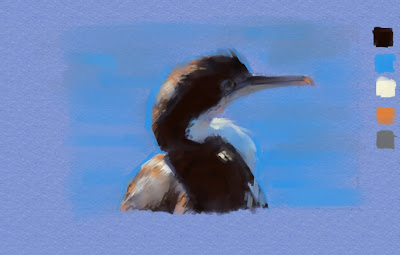
Blurred the back feathers with a grey flat wet brush using light pressure. Twiddled with head outline, toned down the eye, smoothed the beak shape, worked the throat light-dark edge, random pinch and tuck.
And a couple more minutes
I did the changes below after writing this post, so I don't have an accurate number. And it helps to go away from the picture for a while. Helps spot problems.
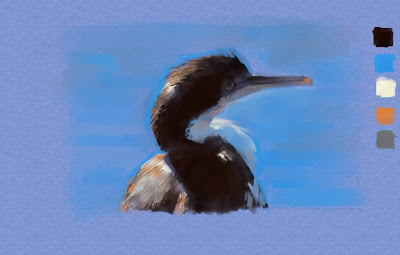
Tweaked head shape, added texture to feathers, popped out the underside of the beak with a lighter edge. Also tweaked the eye shape a little. Done!





